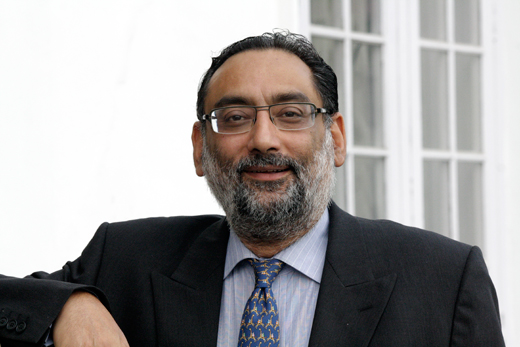At a symposium organized by Export Promotion Council for Handicrafts (EPCH) in association with Entrepreneurship Development Institute (EDI), Chairman J&K Bank and state’s well known economist Dr Haseeb A Drabu delivered key note address. Kashmir Life reproduces excerpts from his speech.

It is a great opportunity for me to be part of the deliberations regarding the issues pertaining to handicraft sector in JK, with specific reference to exports. But I won’t hide my disappointment in the fact that during the last two hours of speeches that we have been listening to, I haven’t heard the word “artisan and craftsmen”!!
The day we recognise that artisans and crafts persons are the core of this sector, start respecting them and giving them their due, the problems plaguing the handicrafts enterprises would be over.
The speakers before me (Director Handicrafts and MD Handicrafts Development Corporation) emphasised that J&K is “rich” in crafts. I agree. What they didn’t say is that the craftsmen are living in poverty, if not penury. How can this business do well, if the producers are not earning enough and have, in fact, been marginalised and effectively work as wage labourers.
There are many artisans here, ask them, do a survey on if they want their children to continue in this line of business. Trust me, they will say “No, we don’t want our children to continue this trade”.
The artisans don’t want their children to follow their footsteps and carry forward their legacy. One should not be surprised by their answer. In a situation where the auto rickshaw driver or a brick kiln labourer earn more than an artisan, what do you expect?
As in everything else, we have mastered the art of excuses. Speaker after speaker said here that the handicrafts trade and exports has been hurt by the 20 years of civil strife and the global recession. True. But global recession is barely 18 months old. What was the situation prior to that? Lets us go back to 1980s. There was no civil strife then. How were our exports doing then? The fact is that in the mid eighties, Kashmiri handicrafts formed a miniscule part in total handicraft exports of the world and contributed less than 0.02 per cent of the global trade. The point I am trying to make is that we have never been able to realise the export potential of our handicraft sector.
To be sure, handicraft is not any ordinary business for us in Kashmir; it is an expression of our priceless cultural heritage. Indeed, it should be called traditional industry as it is but “cultural industry”. As such, if we have to build a sustainable business for handicrafts, we have follow a 3 P approach: preserve, propagate and professionalize.
What will make this sector thrive? Very simply an egalitarian and sustainable business model which will adequately remunerate the craftsmen and provide them a dignified life. The approach has to be to treat this sector as a sub-set of the knowledge economy. It is perhaps the only production activity in which the knowledge and skills are used to create a tangible physical asset at the origin.
There is a lesson to be learnt from the success of software industry. The software companies provided the software developers and their employees ESOPs and virtually made them entrepreneurs.
The opposite has been happening in handicrafts—entrepreneurs have been marginalised to become wage labourers. Far from benefiting the artisan, the person who creates these masterpieces is the one who suffers the most.
The handicraft enterprises are the most ideal for an economy like ours: low capital use, high employment intensity and a wide geographical dispersal. It is a business that can generate huge employment in J&K with minimal use of capital.
There are many problems plaguing the industry. The three main ones are finance, marketing and technology. Operationally the biggest structural problem with this trade is the merger of finance and sales. Those who buy the products are the one who also finance it. The two have to be separated. This will give the artisan a better price discovery mechanism as also greater flexibility in selling. Otherwise he is like a bonded labourer as he is forced to sell to those who finance his production as well as livelihood.
There hasn’t been any technological intervention in the sector. The artisans are still replicating and copying old designs while as the handicraft industries in other countries especially Iran is thriving on the latest designs and use of software technology.
There are two types of technological interventions that need to be made: soft technology like design and branding and hard technology like physical infrastructure which will improve efficiency. There is need to upgrade the present infrastructure and induce scientific interventions into the sector to make it more viable.
The artisan of Kashmir isn’t working in conducive environment and is still seen squatting during work which causes arthritis and other diseases associated with the bones in the later stages. We should provide them better facilities in the form of comfortable seating arrangement so that that he can give in his best and work without any difficulty.
The artisans should also be covered by health insurance so that they can avail the healthcare facilities during their later period of life.
The Kashmiri handicraft sector is also lacking in branding. If we see the product from Belgium and other cloth material in India, they are properly branded, unlike the products made by the artisans in Kashmir which doesn’t have any brand image. The branding of any product is essential to compete in the global market
The artisans and craftsmen don’t need subsidies and industrial policy of the government, but they need a craft policy.
I strongly advocate starting of a MBA in Crafts Management in the University of Kashmir so that the we are able to professionalise this trade and market it around the world along modern lines. It is only then will our exporters be able to realize the full potential.













